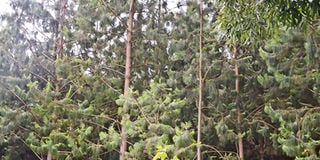Cypress products are pricey, but beware it is a very delicate tree

A tree plantation in Kiambu. Commercially, Cypress is one of the best trees to grow if it can survive to maturity. It can grow up to a height of 100 feet. FILE PHOTO | NATION MEDIA GROUP
What you need to know:
- The commercial value of Cypress includes fencing and power poles, timber, furniture, wood fuel, plywood, pulp and paper.
- If your end objective is timber, you have to wait for between 25-30 years for the tree to mature. This is also its average lifespan.
- For power and fencing poles, it can be harvested at between five and 12 years when a single tree can sell for up to Sh10,000.
- With the frequent changes in weather due to climate change, you are better off planting trees that are more drought resistant.
Of all the tree species I grow, none has given me as much grief as Cypress (Cypresus lusitanica). Since 2005, I have planted about 1,000 mainly on my farm in Soy, Uasin Gishu but I have lost nearly all of them.
The reasons have been varied, both man-made and natural. Farmers need to keep this in mind and know how and when to mitigate the challenges.
The Kenya Forestry Research Institute’s Guide to Tree Planting in Kenya, says that Cypress grows in highland areas of rains between 1,800mm and 3,000mm annually.
With the wisdom of hindsight, I now understand one reason I kept losing Cypress. The place where my farm is located in Uasin Gishu is a plateau with annual rains ranging from 900mm to 1,200mm. But Cypress still grows in the region.
The commercial value of Cypress includes fencing and power poles, timber, furniture, wood fuel, plywood, pulp and paper.
It is used for making boats, roofing trusses, shingles, doors and wood joints. Cypress timber has been used as siding for buildings over centuries especially in coastal areas because it is resistant to damage from moisture. This is also the reason it is ideal for making boats.
If your end objective is timber, you have to wait for between 25-30 years for the tree to mature. This is also its average lifespan.
For power and fencing poles, it can be harvested at between five and 12 years when a single tree can sell for up to Sh10,000.
Timber trees fetch a lot more depending on the number of feet one produces. Cypress timber currently sells at an average of Sh66 a foot, one of the priciest in the market. A 30-year-old tree can produce an average of 2,000 feet.
Of course trees provide other unquantifiable benefits such as improving the climate, regulating stream and river flows and conserving and protecting the soil, according to Kefri.
They also provide stable habitats for wildlife, including insects like bees that play a big role in food production.
Commercially, Cypress is one of the best trees to grow if it can survive to maturity. It can grow up to a height of 100 feet.
VULNERABLE TO PROLONGED DROUGHTS
But it is a delicate species. It is extremely vulnerable to disease and sensitive to changes in the climate. I first planted about 500 Cypress in 2005. In 2010, I lost all of them to a fire.
It was one of those hot, dry and windy December days. My neighbour was preparing her farm for ploughing by burning maize stalks. The fire jumped onto my farm and burnt many trees — mostly Cypress, Grevillea and Blue gums.
Unlike the others which regenerated when the rains came, all the Cypress died.
I planted the next lot in 2011. In 2018, I lost all of them this time to a prolonged drought. Once again, trees like Acacia, Blue gum, Croton and Grevillea survived the drought.
One of the reasons Cypress is such a vulnerable tree is because it has a fibrous, shallow root system. This also means it topples over easily, especially during rainstorms.
For this reason, it is not advisable to plant Cypress in your compound or near buildings and other structures.
Secondly, the shallow root system makes it prone to root rot and several fungal and bacterial diseases. Normally, leaves of an affected tree turn brown before it eventually dies if not treated in good time. Treatment is by spraying with fungicide.
The dry season is the most dangerous. The fungi enter the tree during the hot months when the heat enlarges its pores.
The diseases can be spread from an ill tree to a healthy one during pruning. To prevent this, it is advisable to clean any pruning tools between each cut.
You may also experience infestations of spider mites on trees. A natural solution for this problem is to spray with neem oil insecticide. Another pest that can attack the tree is bagworm; which is eliminated by handpicking then as soon as you see them.
Cypress’ shallow roots also mean it is vulnerable to prolonged drought. This is unlike Blue gum whose tap roots go deep into the soil in search of water.
Unlike a disease which is slow acting and can be mitigated, a drought will quickly destroy your entire plantation.
With the frequent changes in weather due to climate change, you are better off planting trees that are more drought resistant.
Even more important, seek expert advice on the various ecological zones and the trees that grow in them before you plant.




